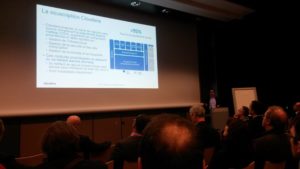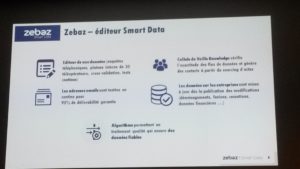Comments from SAS Forum Paris yesterday: Sessions with CLOUDERA and ZEBAZ
0 – The event
After some problems to get an invitation for the SAS FORUM PARIS 2015 event at the “Palais des Congrais” yesterday 5/11/2015, I attended two sessions during the afternoon.SAS used the
SAS used the ConnexMe (http://bit.ly/1WEE3kB) platform, by the organizer Evenium, as a way to communicate the agenda and with the possibility for between-participants communications. As a smartphone application, not simple to explore but works ok as is.The event occupied a smaller area on the 2nd floor and used the adjacent rooms for presentations. As I do not know the SAS team in Paris so I did not have direct interactions with SAS France either.
The event occupied a smaller area on the 2nd floor and used the adjacent rooms for presentations. As I do not know the SAS team in Paris so I did not have direct interactions with SAS France either.
1 – Cloudera session – “Enterprise analysis with Hadoop and Cloudera Enterprise Data Hub

Cloudera is one of the uprising start-ups on the Big Data arena. Jérôme Campo exposed well the Cloudera message as being the “Analysis tools for expanding professions”: Operations, Marketing and Production.
What Cloudera calls the DD&A (Data Discovery & Analytics) has the mission to:
- Be self-service friendly
- Be with advanced analytics features
- Respond to data sciences tasks
The DD&A has the objective to permit the user to have an iterative process in order to understand how to carry out the data-mining but also to understand his own data.
Jérôme exposed several “standard” IS architecture challenges:
- Data sources – Define the right limits
- Storage & Process, Data access and Data analysis – Long delays
- Implementation – Conformity and security issues
Cloudera believes that their platform responds to diminish these challenges, specifically in two areas:
- Architecture: Cloudera is based on and built on what the market would name as a “modern” architecture for database mining and Hadoop friendly thus using the Hadoop elastic file distribution system. This permits a quick implementation of data while being less limited of own IT architectures.
- The vision is to connect with other systems: Cloudera has a focus to render the user experience of the Cloudera platform to not really see the difference (!) when connecting other systems, tools, and databases (speed, usability). This has always been the challenge for data-warehouse-systems. In the case of Cloudera this is based on the platform being a hybrid Open Source.
Cloudera was created in the year 2000 and they are today about 1000 people with 10 people in France. 200 people are engaged in 24×7 schemes for support. 2/3 of R&D works on Open Source development. Cloudera is also a member of the Apache consortium.
SAS and Cloudera work together since 2013 and already have joint-solutions at certain clients. The SAS solutions are able to extract data seamlessly from the Cloudera Data Hub platform via a couple of tools, though.
Jérôme also mentioned one partner-client I really found interesting (as I work on energy monitoring issues in the data centre industry), Ameren (www.ameren.com): They offer to empower energy users by giving them access to analytics tools to both measure and optimize their energy consumption.
2 – Zebaz session – “Smart Data solution to generate qualified B2B leads”

Nicolas Millet at Zabaz, a French “start-up” in the field of big data for marketing leads generation, presented their current solution.
The Zebaz solution offers business operations access to data and to accommodate data to assist the sales teams in their prospection process.
They use 36,000 information sources for company changes, people changes, market information and news etc. One major task, and the challenge for this big data solution, is to render all the data into identifiable companies and individuals.
Zebaz has created their own data category structure for companies (30 categories…) in order to make the information accessible for users. The current use of the rendered information is used to define the sales & marketing strategy to:
- Define commercial development approach (bizdev)
- Identify expanding companies/prospects
- Identify prospects going international
- Assist HR decisions
- Get market buzz (market, companies, news)
- Identify struggling companies/prospects
Their main offer is “Z360” and is the access to the Zebaz platform.

They have also developed connectors for both CRM solutions (SF and Dynamics) and so-called marketing automation systems (Eloqua [www.eloqua.com] and Marketo [www.marketo.com]). This permits to take the data and do something with it within the marketing or sales process. In my view, this may be the most important part but also the most complicated as it needs to remain simple!Nicolas did also expose three business cases with named companies (Dybatrace, Equinix
Nicolas did also expose three business cases with named companies (Dybatrace, Equinix France and Nuance France), which I always find encouraging as many companies do not.
However, they did not explain in which way the Zebaz platform works with SAS, but perhaps not a critical subject.
Competition: I can conclude that the Zebaz solution is very interesting and that there are several interesting French companies (start-ups) in this domain, for example, Salezeo (www.salezeo.com) and IKO System (www.iko-system.com).It should be noted that I am
It should be noted that I am independent of the above companies and information given are my own interpretations and understandings.
